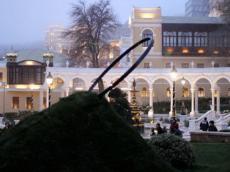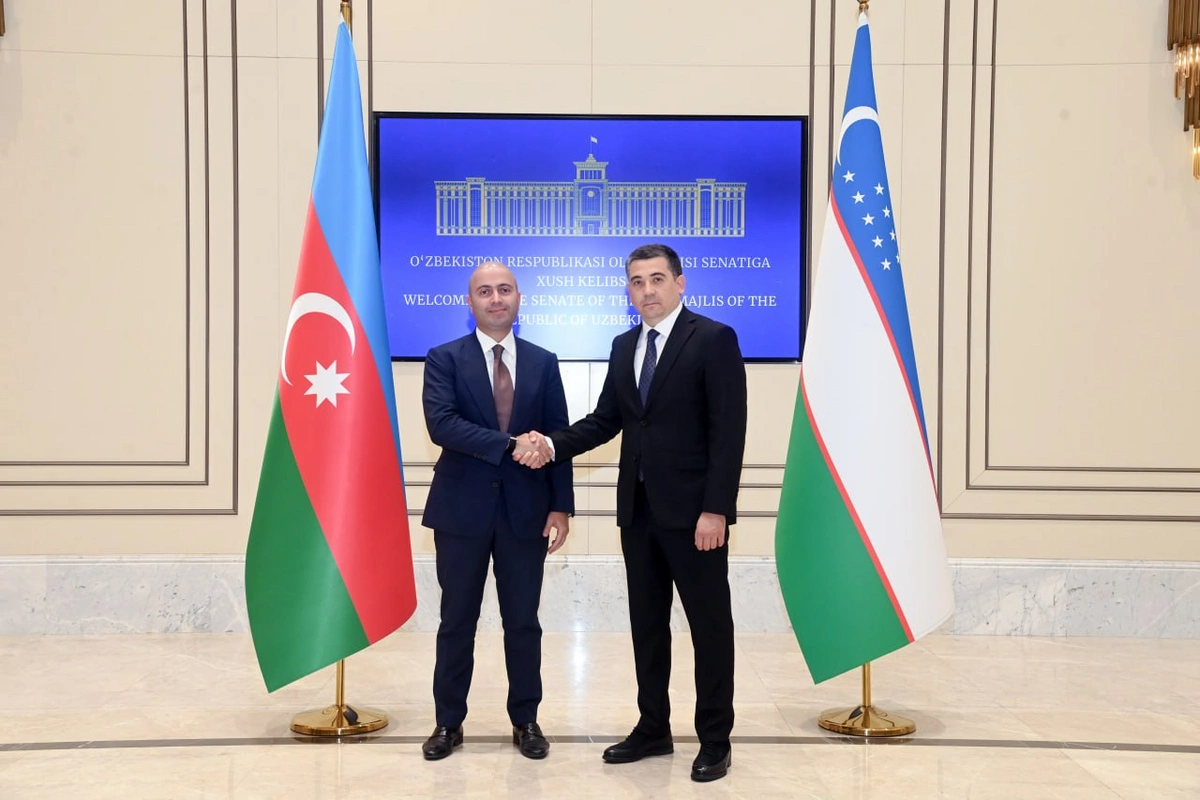|
|
TODAY.AZ / Arts & Entertainment
YARAT! Organization presents "Inner City" project by Faig Ahmed - PHOTOS
07 April 2012 [13:37] - TODAY.AZ
 A presentation of the project of artist Faig Ahmed "Inner City", organized by the YARAT! nonprofit organization dedicated to the promotion of contemporary art of Azerbaijan was held in Governor's park, Baku on Friday. Aida Mahmudova, the creator and founder of YARAT, famous artists and public figures attended the event organized within 012 Baku Public Art Festival.
A presentation of the project of artist Faig Ahmed "Inner City", organized by the YARAT! nonprofit organization dedicated to the promotion of contemporary art of Azerbaijan was held in Governor's park, Baku on Friday. Aida Mahmudova, the creator and founder of YARAT, famous artists and public figures attended the event organized within 012 Baku Public Art Festival.This sculpture depicts a large ring that is pierced into the ground, and then pulled. The lifted ground resembles stretched skin. It feels like a giant finger is trying to pull the ring out and in the process it drags a giant piece of the ground with it.
The process leads to loosening and disruption... It gives an impression of physical extension and symbolizes expansion beyond the physical boundaries. The sculpture will be installed near the fortress wall because it deals with the issue of contraries between the Inner City and the Outer City. Currently such a conflict is self-evident: there is the Inner City (IcheriSheher in Azerbaijanian) that stands behind the fortress wall and the Outer City that is still growing and expanding, covering more and more territories of the Absheron peninsula.
In the beginning of the XIX century there were no such contradiction and the Inner City was the only inhabited area. In the middle of the XIX century after the oil boom the city started to expand rapidly and explored the territory outside the fortress wall. Thus the wall became a borderline, separating Old Baku that had turned into the Inner City from the new one that became the Outer City. With economic development the population of the city grew accordingly...
The Outer City sculpture that will be installed near the fortress wall, reminds us of the times when the expansion had only just began. The art piece stands as a symbol of the dynamics of expansion, and of the tendency to cross borders (status quo) making a leap from "inner" to "outer".
IcheriSheher (the Inner City, also called by people the "Fortress" and the "Old City") occupies an area of 221 thousand square meters. Construction of Palace of the Shirvanshahs memorial complex as well as numerous Caravanserais began under the reign of Khalilullah I, who had moved the capital status from Shemahi to Baku in the XV century.
It helped to "crystallize" the heart of the city - the "Old City", so called IcheriSheher or the "Fortress". From 1747 to 1806 Baku has stayed the capital of the Baku khanate with a capital primarily situated in IcheriSheher.
Since 1806 and especially after the oil boom (middle XIX - early XX centuries) Baku started growing rapidly soon outstepping the fortress's boundary. During the first stage of the oil boom, that took part in the middle of XIX century, Baku has faced significant influx of population and work force. In 1807 there were only 500 residence buildings within the "Fortress", however that number reached 1358 by 1832.
Eventually the poorest class of population such as traders and craftsmen, has formed a suburb just outside the "Fortress", which led to a necessity of transformation and moulding the area.
This also played its part in expansion of the "Fortress". The expression "lcheriSheher" (inner city, old city) appeared only due to expansion of the city out of fortress boundaries during the oil boom. It is well known that Shemakha Gates (also known as "Twin Fortress Gates" and the "Gates of Shakh Abbas") wac the only major entrance to IcheriSheher up to XIX century.
In 1868 the military governor of Baku approached the authorities of Caucasian Military District with a proposition to dismantle the walls of the fortress for further improvement of the city. After two years it was decided to demolish first course of the vallum. In 1886 this issue was brought up for discussion during Duma session, and as a result second course of the vallum was demolished as well. The gates of this tier, called the "Gates of Zulfugar Khan", were moved and placed near the Shemakha Gates.
The 012 Baku Public Art Festival features the work of twenty-one of the finest emerging and established artists in Azerbaijan. Each has been given the task of creating a visual reinterpretation of a setting that holds significance for them within the city. By bringing their work into the public sphere, the artists will gain creative freedom and will achieve a higher level of exposure without the constraints imposed by a gallery or museum.
Works of the following artists will be exhibited: Altai Sadikhzade, Aga Ousseinov, Fuad Salayev, Mammad Mustafayev, Huseyn Haqverdi, Mahmud Rastamov, Teymur Daimi, Niyaz Najafov, Mekhti Mammadov, Rashad Alakbarov, Ali Hasanov, Aida Mahmudova, Faig Ahmed, Farid Rasulov, Leyla Aliyeva, Sitara Ibrahimova, Rashad Babayev, Nail Alakbarov, Orkhan Huseynov, Nazrin Mammadova, Shargiya Rahmanli .
The participating artists belong mainly to a generation of young talent, who have observed the regeneration of Baku, and are passionate about promoting Contemporary Azeri art, whilst staying in touch with their rich cultural heritage.
As part of the 012 Baku Public Art Festival the award-winning film director Rufat Hasanov will be making a documentary to record the project from inception to completion. He will interact with each artist and follow the development of their work in the lead up to the Festival, culminating with the unveiling of the artworks. This film will be shown at the closing ceremony of the 012 Baku Public Art Festival.
Founded in 2011 by Aida Mahmudova, YARAT! is a non-commercial, private organisation dedicated to the promotion and nurturing of Azeri Contemporary art nationally and internationally.
/Trend/
URL: http://www.today.az/news/entertainment/105039.html
 Print version
Print version
Views: 3476
Connect with us. Get latest news and updates.
See Also
- 13 September 2025 [15:49]
Shamakhi gears up for Grape and Wine Festival - 13 September 2025 [14:48]
Head of Caucasian Muslims Board to visit Kazakhstan for Astana Congress events - 12 September 2025 [19:01]
Azerbaijan's gastronomic delights highlighted in Paris - 12 September 2025 [18:21]
Cinema Agency holds meeting with film director Hilal Baydarov - 12 September 2025 [15:18]
Nizami Cinema hosts film retrospective honoring Maksud Ibrahimbayov - 12 September 2025 [13:53]
Teachers excelling in arts education to be awarded Uzeyir Hajibayli Prize - 12 September 2025 [12:16]
New concert season begins at International Mugham Center - 11 September 2025 [12:57]
Exhibition 'Timeless and Space-less' to open within Nasimi Festival - 10 September 2025 [14:56]
The Rasmus ready to rock Baku with long-awaited show - 10 September 2025 [14:15]
Bulbul Vocal School selects new students
Most Popular
 Uzbekistan, Azerbaijan agree to strengthen inter-parliamentary cooperation
Uzbekistan, Azerbaijan agree to strengthen inter-parliamentary cooperation
 US Congress refused to consider anti-Azerbaijani amendments - the failure of the Armenian lobby in Washington
US Congress refused to consider anti-Azerbaijani amendments - the failure of the Armenian lobby in Washington
 And you will be cured! Mikhalkov as a crazy "lightning rod" of Russian propaganda
And you will be cured! Mikhalkov as a crazy "lightning rod" of Russian propaganda
 Remains of four fallen soldiers from First Garabagh War to be laid to rest
Remains of four fallen soldiers from First Garabagh War to be laid to rest
 National Assembly backs Washington declaration, bolstering Azerbaijan’s global role
National Assembly backs Washington declaration, bolstering Azerbaijan’s global role
 ADB reports major progress in reconstruction of Sumgayit–Yalama railway line
ADB reports major progress in reconstruction of Sumgayit–Yalama railway line
 Azerbaijan, Pakistan discuss expanding trade and investment cooperation
Azerbaijan, Pakistan discuss expanding trade and investment cooperation







